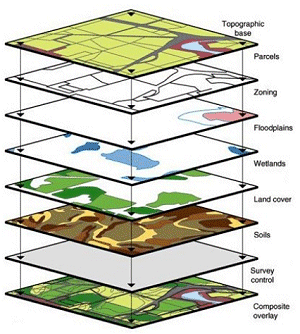The importance of the public’s participation in the process is tantamount in avoiding further conflict and objection once a development has been undertaken. “The picture is worth a thousand words and direct involvement in most endeavors results in a greater understanding of the experience” (Howard, 1998). Unfortunately the wisdom of this phrase has not fully been understood by the planning world as yet. The message here is clear, greater involvement in the planning process leads to greater understanding and acceptance of plans and proposals. Therefore any process which will improve the relationship between planners and the community they serve will inevitably result in a more fair and efficient planning system.
(Shiffer, 1996) writes, "Information is only powerful when it is effectively comprehended by those who use it. IT (Information Technology) can help people to comprehend information, (thereby delivering knowledge)." Nearly all planning information possesses a spatial orientation that is essential to acquiring the knowledge necessary for effective planning participation. (Shiffer, 1995a) and others (Hundt 1997, Krygier 1998, Pieplow 1998) have demonstrated that geographically related technology, including:
GIS Concept
Digital Aerial Photography
geographic information systems (GIS); digital aerial photography and photographs; digital simulation and animation; and even audio/video recordings of public meetings where land use issues are discussed can be employed during participatory activities to provide that geographic orientation.
(Dandekar, 1982) suggests that involvement of the public to stimulate good ideas and build a consensus amongst a diverse community requires three modes of communication: presentation of information to the public; receipt of information from the public; and exchange of ideas and opinions that build upon shared information as the ideas evolve. The importance of information exchange between the public and the local planning authorities, ICT infrastructure can play a major role in stimulating this process.
(Kaj, 2002) said that electronic tools can overcome many traditional obstacles in the aspect of reaching out to the public with the information. Among the traditional obstacles that can be overcome are,
i. Preparation of information in the form of electronic data can reduce the cost on hardcopy printing materials (reduced usage on paper).
ii. The public will be able to reach out to certain information or documents through the internet, at their own preference time without disturbing their normal day routine.
iii. There will be no need for the public to go the authorities office to gather the information that they need, in fact this can be done anywhere with internet connection
iv. The electronic information usage in different from the traditional information usage, although both convey the same information but the electronic information has the advantage that enable the public to do information search electronically, Cut and Paste of the information, alteration and correction on the information can be done much easier.

















No comments:
Post a Comment